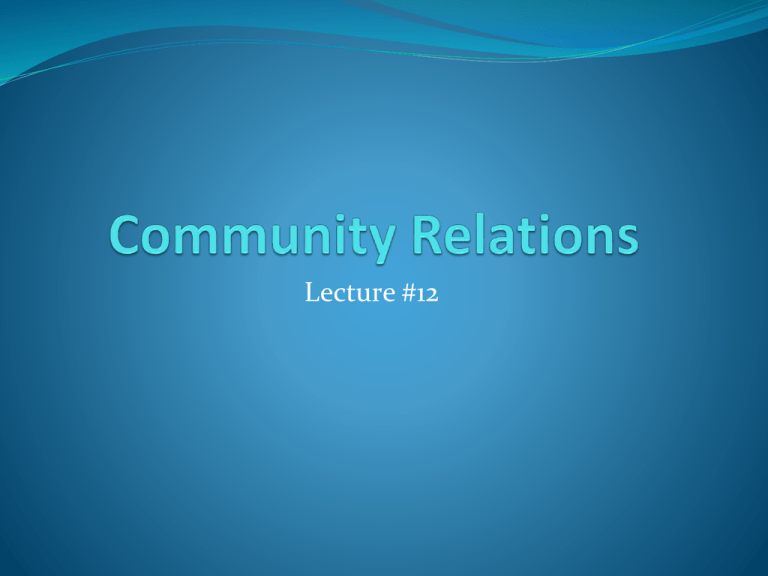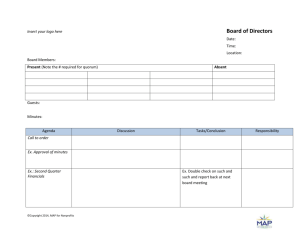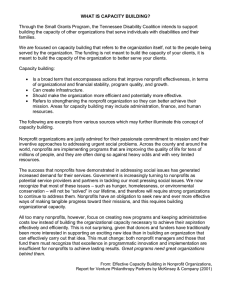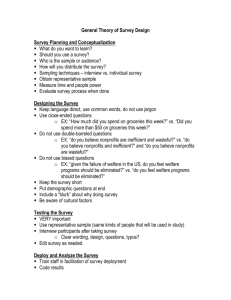ElliottK 2012-1 EXTRA12
advertisement

Lecture #12 In Class Assignment #7 List 5 ways that a fashion organization could be involved in their community? Community Relations In the 21st century organizations know that they must work with the communities in which they operate. Organizations often choose to help nonprofit organizations. During times when the economy is rough, and corporate spending is low, nonprofits must go hard to earn contributions from big corporations. Community Relations Organizations must participate with and give back to the communities they operate in so that they can solve today’s societal issues. Community Social Responsibility The workforce is becoming more diverse. As employees enter the work arena with different backgrounds, educations, ages, genders, races, ethnicities, physical abilities, religious beliefs, orientations, and other differences, it makes organizations work much harder to communicate with all of their employees. More and more organizations are recognizing their responsibilities to the community: clean air, water, providing jobs to minorities, helping the interests of all employees, and increasing the quality of life. Corporate Charity 2007- over $306 billion in charitable contributions Nonprofits rely on corporate contributions, when the economy goes down, so do contributions. Corporate leaders have begun taking public stances on confronting societal challenges. Volunteerism is also considered a charitable contribution. Often used in place of monetary contributions. As more corporations give to their charities, they feel they should be a part of them, as well. More corporations are volunteering with the groups they give to. Milton Friedman Believes: Corporations have the responsibility to make money and sell products, so that they can hire individuals. It is the individual’s responsibility to serve society though philanthropy. Community Relations Expectations Three expectations: Determine what the community knows/thinks about the organization. Informing the community about the organization’s point of view. Negotiating between the organization and the community and its constituents if there is a significant discrepancy. What the Community Expects Communities expect wages, jobs, taxes, etc. But they also need other things as well. Appearance- hopes that the organization will contribute positively to the life in the area. Focus on beautification and don’t pollute. Participation- organizations are expected to participate in community affairs; parks and recreational activities, welfare, education Many retailers help nonprofits by participating in fundraisers, helping with cleaning, and also do holiday contributions similar to adopt a family. What the Community Expects Stability- if an organization fluctuates from the number of employees, amount of volume the organization completes, and taxes paid, it will impact municipal services, school sizes, public facilities, and tax revenues. Communities prefer to have organizations that do not fluctuate much in order to keep these other numbers stable. What the Community Expects Pride- An organization that can help put a city on a map is preferred by most communities. These organizations help build towns and cities. Bentonville,ARK- Walmart, Fort Wayne, IND- Vera Bradley, Hershey, PENN- Hershey’s Chocolate Think of almost any big college town. Would people know where they are if the colleges did not exist? What Organizations Expect Organizations also expect to gain something in return from their communities. Good Municipal Services Fair Taxation Good Living Conditions for Their Employees Pool of Qualified Labor When these cannot be provided, organizations move locations. Community Relations Objectives Winning community support can be a difficult task. Many communities want to receive help from corporations, but do not want to feel the pressures of any dominance. Community Relations Objectives To tell the community about the operations of the organization- products, number of employees, size of payroll, tax payments, employee benefits, growth. To correct misunderstandings- reply to criticism, and remove any concern. Gain favorability of the community- particularly during strikes by stating the company’s position on the issue. Community Relations Objectives Inform employees and families about activities and developments- employees are likely to tell others, which helps create a positive opinion of the organization. To inform people in local government- contributions to local welfare and obtain support from legislation that will have a favorable affect the business. To find out what residents think about the organization- why they like or dislike policies and practices, how much they now about the organization’s problems. Community Relations Objectives To establish a personal relationship between management and community leaders- inviting leaders to make visits, meet management, and see employees at work. To support health programs- through both funds and employee services. To contribute to culture by providing funds for art exhibits, concerts, and festivals, and by promoting attendance to these events. Community Relations Objectives To aid youth and adult education- administrations working to mentor students, provide internship opportunities, providing guest speakers from the organization. Encourage sports and recreation- providing sports fields, tennis courts, and swimming pools, as well as, sponsoring sports teams. Promote better local and community governmentencourage employees to run for public office and serve on administrator’s boards. Community Relations Objectives To assist local economy- purchase operating supplies and machinery from local organizations when feasible. Operate a profitable business so that it can hire, retain, and pay workers so that they can go out at purchase in the local economy. Cooperate with other local organizations to advance economic and social welfare through joint community programs. Diversity of Community Relations 38 million Americans are foreign born. Latinos- largest minority group, 45.5 million 41 million blacks 15 million Asians Women were once a minority in the PR field, now they dominate the area. Organizations must be sensitive to minority groups. Must offer equal pay, promotional opportunities and equal rights in the workplace. Diversity of Community Relations Women: Head large corporations Have climbed into middle and upper-management positions Diversity in Community Relations Hispanics: Fastest growing minority in America Becoming a stronger voting population Spend nearly $400 billion a year Huge media consumers Diversity in Community Relations Blacks: Slowed in growth since recent years Blacks have a much lower household income- $35,000 vs. $60,000 Disposable income has increased in recent years, over $700billion a year The field has failed to attract African Americans Efforts have been made to attract diversity in the PR field, includes the D. Parke Gibson Award. Diversity in Community Relations Asians: 15 million- mostly in California They have gained new status as consumers Life has been much harder on Muslims since the attacks of 9/11 Diversity in Community Relations Gays: 12-20 million Americans 16 LGBT characters appeared on television network programs Some organizations offer benefits and protections to LGBT employees Increase of gay themes in advertising Attitudes toward gay people are changing Household income is nearly 6 times higher than national average, higher discretionary income. Diversity in Community Relations Senior Citizens: Important community for those working in PR As the population grows older, it becomes more important to focus on them as consumers, voters, and opinion leaders. PR professionals must realize that this group deserves specialized treatment and targeted communications Working with Nonprofits Nonprofit organizations serve the cultural, social, educational, and religious needs in their communities. This is a primary sector for public relations professionals. Hospitals, schools, trade associations, cultural organizations, chamber of commerce, welfare agencies, religious institutions, and many others. Nonprofits seek to earn public support of their mission and programs through effective communication. They also seek to broaden their volunteer base. Public Relations Function in Nonprofits Because nonprofits do not have a lot of resources for key activities, especially in times when the economy is rough, public relations professionals are hired and serve as the master of many functions. Public Relations Function in Nonprofits Positioning the Organization: nonprofits must stand out because they are all competing for the funds or community organizations. To stand out, the professional must ask several questions of the organization. What position do we have, who are we? What position do we want? Who else is out there and what is there position? Do we have the funds to get us where we want to be? Can we stick it out over time? Do all communications line up with each other? Public Relations Function in Nonprofits Develop a Marketing/Promotional Plan: often the PR professional serves as the marketing, advertising, and promotional director of the nonprofit. Must market the nonprofit: raise respect, profile, and support. Must plan the audience, messages, and vehicles for those messages 1. Plan 2. Define Issues 3. Build Strategies 4. Frame Issues 5. Develop Talking Points 6. Choose Spokespersons 7. Develop Comm. Materials 8. Target Messages Public Relations Function in Nonprofits Media Relations: because most nonprofits lack resources for advertising, they must seek out “free” media by reaching out to the media. Talk Radio- extensive audience Cable Television Op eds.- opinion editorials done by nonprofit executives—get nonprofit points of view across to influential individuals Cable Access- community channels are generally willing to provide opportunities for nonprofits Web Access- internet provides limitless chances for nonprofits to spread their word. Public Relations Function in Nonprofits Supporting Fundraising: nonprofits depend on donors/members for support. Fundraising- the need to raise money to support operations. It is part of every nonprofit. Nonprofits cannot exist without a source of private funds. Public Relations Function in Nonprofits Fundraising campaigns should include: Identifying Campaign Plans and Objectives: financial targets set, goals set, target for getting funds. Organize Fact-Finding: relative trends that might affect giving- events taking place on the same date, economy, recent natural disaster relief, etc. Recruit Leaders- best campaigns have strong leadership. Plan and Implement Strong Comm. Plans- publicity and promotions are crucial. Special events should have local/national celebrities Periodically Review and Evaluate: review the progress of the campaign, strategies and techniques. Final Thoughts PR professionals must be aware of the diversity within the organization and community they work for. Just as you expect things from the community you operate in, they expect the same; fair wages, jobs, stability, good air and water. The PR professional often plays many roles in nonprofit organizations. One of the most important elements of a PR professional working for a nonprofit organization is fundraising. References Seitel, F.P. (2011). The Practice of Public Relations. Prentice Hall: Boston.





